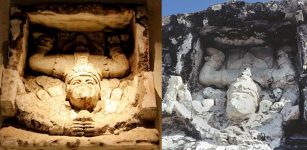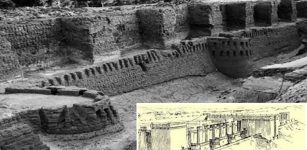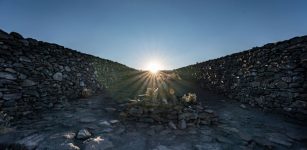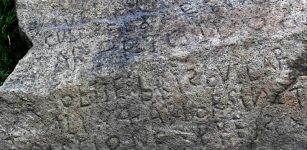Preserve Elfdalian: Sweden’s Secret Forest Language From The Viking Era
A. Sutherland - AncientPages.com - Elfdalian (in Swedish: Älvdalska) is a very ancient relative of Swedish (maybe even more 'Swedish' than it is spoken today).
Some call it a dialect, but most linguists agree it's more complicated than that. The language has been spoken in northwestern Dalarna since the Viking era, almost as ancient Swedish as anything else.
In this remote part of Sweden, people used runes until just a hundred years ago. However, most people associate runes with the Viking age. Still, in Älvdalen in western Sweden, the local population continued to use runes for centuries after the rest of Scandinavia had abandoned the ancient written language.
Hidden deep in the Swedish forests, the runes were allowed to live on until the early 20th century, just as the inhabitants retained their exceptional language Elfdalian, considered a veritable treasure chest for Scandinavian linguists.
"Älvdalen really is something very special. Firstly, because they speak a unique old Norse tongue and also because they used runes until a hundred years ago. It's absolutely fascinating," says Michael Lerche Nielsen, an assistant professor at the Department of Nordic Research at the University of Copenhagen.
The runic script was the dominant written language in Denmark and the rest of Scandinavia until the advent of Christianity in the ninth and tenth centuries introduced the Latin alphabet.
By the 15th century, the Latin alphabet had almost wiped out the use of runes – but not in Älvdalen.
Here, the Swedish linguist Henrik Rosenkvist recently saw a letter dated 1906 written partly in runes.
"The runes we see in Älvdalen are probably the most recent use of the script we know of. Runes otherwise died out in the Middle Ages, so their use in recent times is exceptional," says Rosenkvist who speaks and studies the unique language spoken in Älvdalen.
The runes of Älvdalen ('dalrunerne') are reminiscent of those used on runes stones in Denmark but there are a number of differences. Dalrunerne developed over time, influenced partially by the Latin alphabet. Here are the runes as they looked in the period leading up to the 20th century. (Illustration: Tasnu Arakun/Wikimedia Commons)
According to Nielsen, the runes in Älvdalen were most commonly found on houses and inscribed in furniture.
"The use of runes in Scandinavia gradually ceased during the 15th century. There are the odd areas of Gotland in Sweden and in Iceland where the rune tradition survived until the 17th century, but in Älvdalen, their use was widespread until the early 20th century," he says.
Bilingual road signs in Älvdalen parish, Sweden, in Swedish and Övdalian. Image credit: Lundgren8 - CC BY-SA 4.0 DEED
People in Älvdalen kept on using runes after the ancient script had been abandoned by the rest of the nation.
In addition, they were also engraved into' message blades' which were sticks of wood circulated among the farms in the area.
The landscape surrounding Älvdalen effectively cuts the community off from the rest of Sweden through mountains, forests, and lakes.
It was precisely the area's isolation from the rest of the country that lies behind the survival of the runes and the unique language -- while the rest of the country was flooded by the Latin alphabet, Germanic words, and modern Rikssvensk.
Rune inscription from 1635 - the Swedish province Dalarna. Photo credit: wikipedia
"Älvdalen lies extremely deep within the Swedish forests and mountains. You can get there by boat up the river, Dalälven -- a journey of more than 100 kilometers -- and getting there and back used to be quite an expedition.
So people in the area weren't particularly mobile and were able to preserve this very special culture, considered in Sweden to be extremely traditional and old fashioned," says Nielsen.
People in Älvdalen are a little conservative -- in a good way. They kept themselves very much to themselves," says Rosenkvist.
Image credit : Dalmålsakademin
"Another important reason is that sending your children to school wasn't obligatory in Sweden. Until the mid-19th century, many children didn't attend school, and until then, people simply kept on using the runes as their written language. When they started going to school, however, they only ever used the Latin alphabet and the use of runes gradually died out," he says.
Written by – A. Sutherland - AncientPages.com Senior Staff Writer
Updated on January 30, 2024
Copyright © AncientPages.com All rights reserved. This material may not be published, broadcast, rewritten or redistributed in whole or part without the express written permission of AncientPages.com
Expand for referencesMore From Ancient Pages
-
 Long-Lost Tomb Of Pharaoh Thutmose II Finally Found In Luxor, Egypt
Archaeology | Feb 19, 2025
Long-Lost Tomb Of Pharaoh Thutmose II Finally Found In Luxor, Egypt
Archaeology | Feb 19, 2025 -
 Ancient Maya Destroyed Their Environment 2,000 Years Ago – Effects Are Still Visible Today
Civilizations | Sep 9, 2015
Ancient Maya Destroyed Their Environment 2,000 Years Ago – Effects Are Still Visible Today
Civilizations | Sep 9, 2015 -
 Nazi Photo Album Made Of Human Skin Found At Polish Antiques Market
History | Mar 18, 2020
Nazi Photo Album Made Of Human Skin Found At Polish Antiques Market
History | Mar 18, 2020 -
 Vijayanagara King Bukkaraya’s Earliest Inscription Discovered
Archaeology | Oct 7, 2015
Vijayanagara King Bukkaraya’s Earliest Inscription Discovered
Archaeology | Oct 7, 2015 -
 Siege Of Masada – The Last Stand Against The Roman Empire
Civilizations | Mar 27, 2017
Siege Of Masada – The Last Stand Against The Roman Empire
Civilizations | Mar 27, 2017 -
 On This Day In History: “Man In The Iron Mask” Died In The Bastille, Paris, France – On Nov 19, 1703
News | Nov 19, 2016
On This Day In History: “Man In The Iron Mask” Died In The Bastille, Paris, France – On Nov 19, 1703
News | Nov 19, 2016 -
 Ancient Maya Ruins Of Tulum: Sea Port And Sacred Site For Worshiping Of Descending God
Featured Stories | Aug 10, 2016
Ancient Maya Ruins Of Tulum: Sea Port And Sacred Site For Worshiping Of Descending God
Featured Stories | Aug 10, 2016 -
 Study Reveals Average Age That Women And Men Had Children Over Past 250,000 Years
DNA | Jan 10, 2023
Study Reveals Average Age That Women And Men Had Children Over Past 250,000 Years
DNA | Jan 10, 2023 -
 Bes: Egypt’s Intriguing Dwarf God Of Music, Warfare And Protector Against Snakes, Misfortune And Evil Spirits
Egyptian Mythology | Jul 31, 2016
Bes: Egypt’s Intriguing Dwarf God Of Music, Warfare And Protector Against Snakes, Misfortune And Evil Spirits
Egyptian Mythology | Jul 31, 2016 -
 Massive Fortress Buhen In Ancient Capital Of Egyptian Nubia
Archaeology | Mar 20, 2017
Massive Fortress Buhen In Ancient Capital Of Egyptian Nubia
Archaeology | Mar 20, 2017 -
 How King Arthur Became One Of The Most Pervasive Legends Of All Time
Featured Stories | Feb 12, 2017
How King Arthur Became One Of The Most Pervasive Legends Of All Time
Featured Stories | Feb 12, 2017 -
 Remarkable Marble Fragment From The Temple Of Zeus In Akragas Found Underwater Off The Coast Of Sicily
Archaeology | Feb 6, 2024
Remarkable Marble Fragment From The Temple Of Zeus In Akragas Found Underwater Off The Coast Of Sicily
Archaeology | Feb 6, 2024 -
 Hidden History Of Skull And Crossbones: The Untold Story Of The Templar And Their Connection To The Shining Ones
Featured Stories | Aug 6, 2018
Hidden History Of Skull And Crossbones: The Untold Story Of The Templar And Their Connection To The Shining Ones
Featured Stories | Aug 6, 2018 -
 On This Day In History: Amelia Earhart’s First Solo Ocean Flight – On Jan 11, 1935
News | Jan 11, 2017
On This Day In History: Amelia Earhart’s First Solo Ocean Flight – On Jan 11, 1935
News | Jan 11, 2017 -
 Ancient Mexicans’ Precise Solar Observations Fed Millions – Remarkable Farming Calendar Invented
Archaeoastronomy | Dec 12, 2022
Ancient Mexicans’ Precise Solar Observations Fed Millions – Remarkable Farming Calendar Invented
Archaeoastronomy | Dec 12, 2022 -
 Ancient Babylonian Astronomical Records Confirm Slowing Of Earth’s Spin
Archaeology | Dec 20, 2016
Ancient Babylonian Astronomical Records Confirm Slowing Of Earth’s Spin
Archaeology | Dec 20, 2016 -
 Mysterious Rock Inscription Found In Brittany Baffles Experts – Reward If You Can Decipher It
Archaeology | May 15, 2019
Mysterious Rock Inscription Found In Brittany Baffles Experts – Reward If You Can Decipher It
Archaeology | May 15, 2019 -
 Palermo Stone: One Of The Earliest History Records Of Ancient Egypt
Artifacts | Apr 15, 2016
Palermo Stone: One Of The Earliest History Records Of Ancient Egypt
Artifacts | Apr 15, 2016 -
 Living Descendant Of Legendary Native American Leader Sitting Bull Confirmed Using DNA From Hair
Archaeology | Oct 27, 2021
Living Descendant Of Legendary Native American Leader Sitting Bull Confirmed Using DNA From Hair
Archaeology | Oct 27, 2021 -
 Millet Bread And Pulse Dough From Early Iron Age South India
Archaeology | Dec 20, 2021
Millet Bread And Pulse Dough From Early Iron Age South India
Archaeology | Dec 20, 2021







